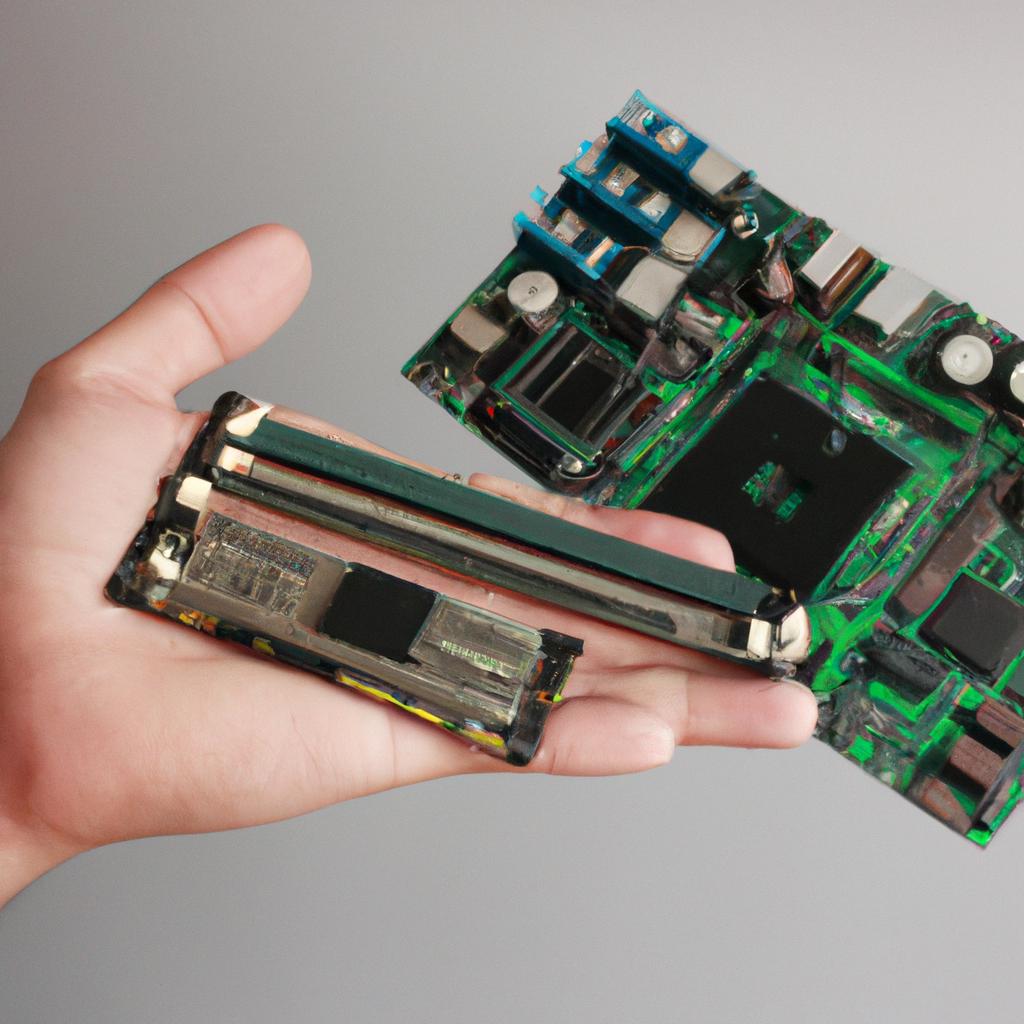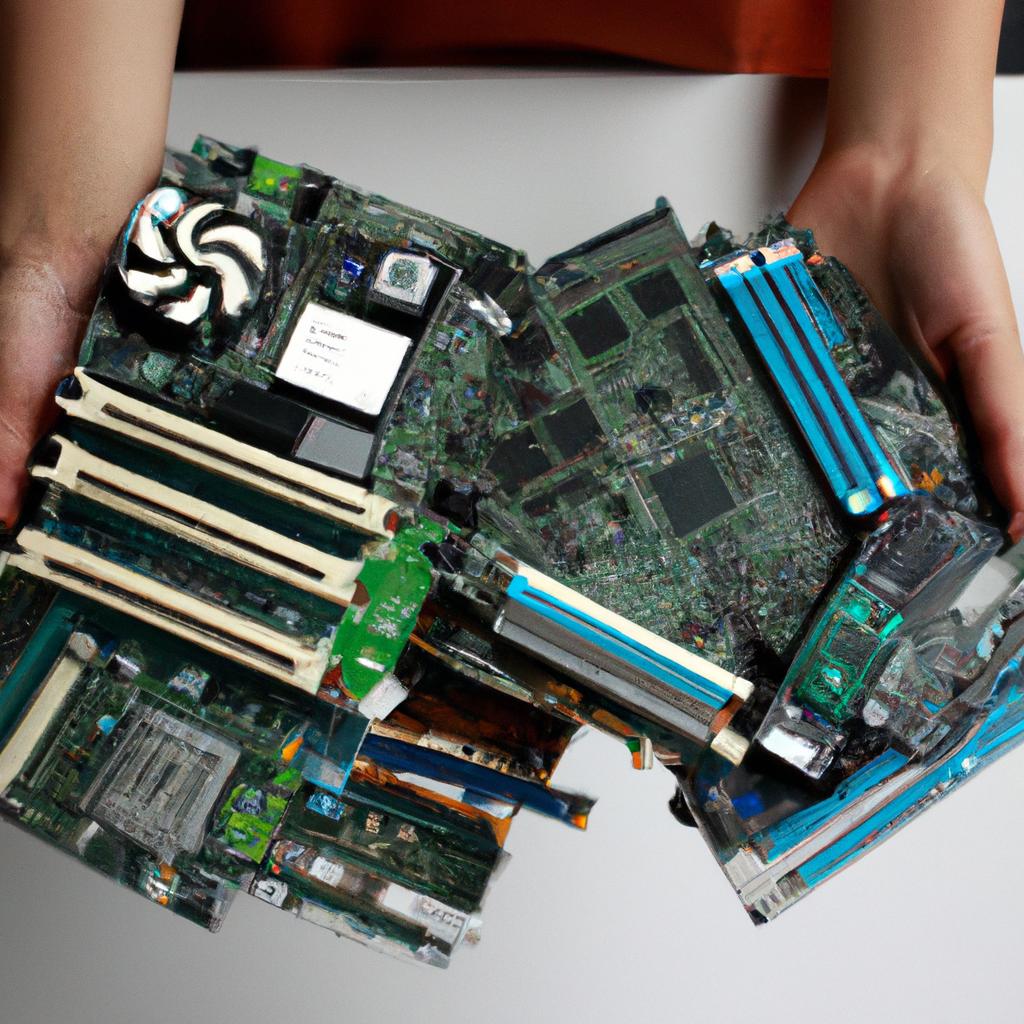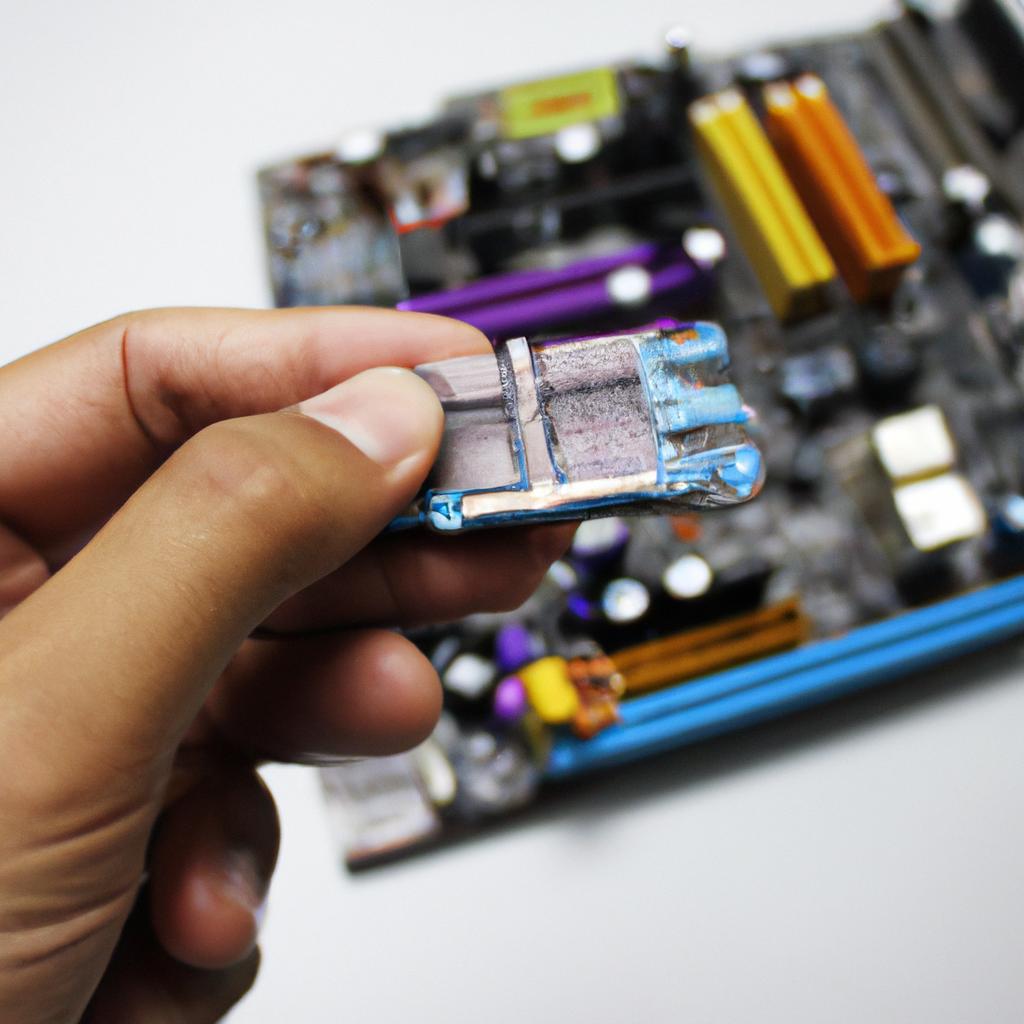The compatibility of processor sockets is a crucial aspect in the field of computer hardware, as it directly affects the upgrade options for users. One example that highlights this importance is the Socket FM2+ platform developed by AMD. This article aims to explore and analyze the compatibility features of Socket FM2+, focusing on its ability to support various processors within the same socket. By examining real-world scenarios and technical specifications, this article will shed light on how AMD has designed its platform to provide flexibility and longevity for both casual users and enthusiasts.
In today’s rapidly evolving technological landscape, where new advancements are continually being introduced, having a compatible motherboard socket becomes paramount. The Socket FM2+ platform stands out due to its unique capability to accommodate different generations of Advanced Micro Devices (AMD) processors within a single socket interface. This means that users can enjoy an extended lifespan for their motherboards without needing to replace them entirely when upgrading their CPU. Understanding the intricacies of this compatibility feature is essential for individuals who seek long-term investment in their computing systems or wish to maintain backward compatibility with older processors.
Socket FM2+ explained
Imagine you are a computer enthusiast looking to build your own gaming rig. You have carefully selected all the components – powerful graphics card, high-speed RAM, and a spacious solid-state drive. However, one crucial component that often goes unnoticed is the socket. In this section, we will delve into the world of Socket FM2+, exploring its compatibility and significance in modern computing.
To begin with, let us consider an example scenario. Meet John, an avid gamer who wants to upgrade his existing desktop system. He has heard about the benefits of Socket FM2+ and wonders if it would be compatible with his current setup. This real-life case study provides insight into the practical implications of choosing the right socket for your needs.
Socket FM2+ boasts several key features that make it an attractive choice for both casual users and professionals alike:
- Enhanced performance: With support for advanced processors from AMD’s A-series and Athlon X4 lineup, Socket FM2+ ensures excellent performance across various tasks.
- Future-proofing capabilities: The backward compatibility offered by Socket FM2+ enables users to leverage newer processors while still utilizing their existing hardware infrastructure.
- Affordability: Compared to other sockets on the market, Socket FM2+ offers a cost-effective solution without compromising on performance or reliability.
- Versatility: Whether you are building a budget-friendly PC or aiming for top-tier gaming experiences, Socket FM2+ caters to a wide range of user requirements.
Now let’s take a closer look at how these features translate into tangible benefits through a comparison table:
| Feature | Description |
|---|---|
| Enhanced Performance | Enjoy smooth multitasking and seamless gameplay with high-performance processors supported by Socket FM2+. |
| Future-proofing Capabilities | Stay up-to-date with evolving technologies as new processor options become available while preserving your investment in existing components. |
| Affordability | Get the most out of your budget with Socket FM2+, which offers a cost-effective option compared to other sockets in the market. |
| Versatility | From everyday computing tasks to demanding gaming experiences, Socket FM2+ accommodates various user needs and preferences. |
In summary, Socket FM2+ provides an excellent foundation for building or upgrading a computer system, ensuring enhanced performance, future-proofing capabilities, affordability, and versatility.
Let us now transition into exploring “Socket FM2+ processors” and how they complement this versatile socket design.
Socket FM2+ processors
Building upon the understanding of Socket FM2+ architecture, let us now explore its compatibility with AMD processors. To illustrate this further, consider a hypothetical scenario where you are planning to upgrade your existing computer system.
Socket FM2+ processors offer a wide range of options suitable for various computing needs. These processors are designed to fit into the Socket FM2+ motherboard socket and provide efficient performance. With advancements in technology, these processors incorporate features such as multiple cores, higher clock speeds, and improved power efficiency.
To better comprehend the compatibility between Socket FM2+ motherboards and AMD processors, we can highlight some essential factors:
- Processor Support: Socket FM2+ accommodates several generations of AMD A-Series APUs (Accelerated Processing Units) and Athlon X4 CPUs. Ensure that you check the specific processor support list provided by the motherboard manufacturer before making any purchase decisions.
- Memory Compatibility: The memory controller integrated within Socket FM2+ processors supports DDR3 modules running at different frequencies. It is crucial to verify whether your chosen motherboard supports the desired RAM frequency for optimal performance.
- Power Requirements: Different processors have varying power requirements. When selecting a compatible processor for your Socket FM2+ motherboard, it is vital to ensure that both devices align regarding their power supply specifications.
- Form Factor Considerations: Depending on your intended usage and available space within your PC chassis, it is important to select a processor that fits your desired form factor. Most modern Socket FM2+ processors adhere to standard form factors like microATX or ATX.
Table example:
| Processor Model | Cores | Clock Speed (GHz) | Integrated Graphics |
|---|---|---|---|
| A10-7850K | 4 | 3.7/4 GHz | Radeon R7 |
| Athlon X4 860K | 4 | 3.7 GHz | No |
| A8-7600 | 4 | 3.1/3.8 GHz | Radeon R7 |
| Athlon X4 750K | 4 | 3.4 GHz | No |
In summary, Socket FM2+ compatibility with AMD processors offers a versatile range of options for upgrading or building your computer system. By considering factors such as processor support, memory compatibility, power requirements, and form factor considerations, you can make informed decisions when selecting the appropriate components.
Moving forward to explore the intricacies of Socket FM2+ motherboards, we will delve into their features and capabilities without further ado.
Socket FM2+ motherboards
Case study example:
To better understand the compatibility of socket FM2+ processors and motherboards, let’s consider a hypothetical scenario where an individual plans to upgrade their existing system. The current setup consists of an older generation AMD processor and motherboard. They are looking for improved performance and want to explore the options available within the socket FM2+ platform.
Socket FM2+ processors offer enhanced features such as higher clock speeds, increased core counts, and improved power efficiency compared to previous generations. These advancements can significantly boost overall system performance in various computing tasks, including gaming, content creation, and multitasking.
When considering compatibility between socket FM2+ processors and motherboards, it is essential to take into account the following factors:
- Processor support: Ensure that the chosen motherboard supports the specific socket FM2+ processor you intend to use. Manufacturers often provide detailed documentation listing compatible models.
- BIOS update requirement: Some older motherboards may require a firmware update (BIOS) to support newer socket FM2+ processors fully. Check with the manufacturer if your motherboard needs an update before proceeding.
- Memory compatibility: Verify whether your existing RAM modules are compatible with both the new socket FM2+ processor and motherboard. This will help avoid any issues when upgrading.
- Power requirements: Consider if your power supply unit can handle the power demands of the upgraded components adequately. Upgrading to a more powerful CPU might necessitate a PSU upgrade as well.
The table below provides an overview of exemplary socket FM2+ processors along with their key specifications:
| Processor Model | Cores/Threads | Base Clock Speed | Max Boost Clock |
|---|---|---|---|
| AMD A10-7850K | 4/4 | 3.7 GHz | 4 GHz |
| AMD Athlon X4 860K | 4/4 | 3.7 GHz | 4 GHz |
| AMD A8-7600 | 4/4 | 3.1 GHz | 3.8 GHz |
| AMD Athlon X2 370K | 2/2 | 4 GHz | N/A |
As evident from the table, socket FM2+ processors come in various configurations to suit different user requirements, ranging from quad-core options with higher clock speeds for power users to dual-core alternatives suitable for basic computing needs.
Taking into account these factors and considering the available upgrade options within the socket FM2+ platform, individuals can make informed decisions based on their specific needs and budget constraints. In the subsequent section about “Socket FM2+ upgrade options,” we will explore further steps one can take to maximize system performance and compatibility.
Socket FM2+ upgrade options
Transitioning from the previous section on Socket FM2+ motherboards, let’s now explore the compatibility of this AMD platform socket. To illustrate its functionality and benefits, consider a hypothetical scenario where a user wants to upgrade their existing motherboard to support more advanced processors.
One example of a compatible processor for the Socket FM2+ is the AMD A10-7850K APU. This quad-core processor offers impressive performance with integrated Radeon R7 graphics, making it suitable for casual gaming and multimedia tasks. With an unlocked multiplier, it also provides overclocking capabilities for enthusiasts seeking additional power.
When considering compatibility between Socket FM2+ motherboards and processors, there are some key factors to keep in mind:
- CPU Compatibility: It is essential to ensure that the selected motherboard supports the desired processor model. While Socket FM2+ motherboards are designed for AMD APUs, they may have limitations when it comes to specific models or generations.
- BIOS Updates: As technology evolves, motherboard manufacturers often release BIOS updates to improve system stability and add support for newer processors. Before purchasing a new processor, check if your chosen motherboard requires any firmware updates to be compatible.
- Power Delivery: Depending on your intended usage and preferred processor model, make sure that the motherboard can provide sufficient power delivery through appropriate VRM (Voltage Regulator Module) design and quality components.
- Expansion Slots and Features: Consider other features you require in a motherboard such as PCIe slots for expansion cards, USB ports, M.2 slots for storage devices, or RAM capacity.
To further emphasize these considerations visually, here’s a table summarizing different aspects of compatibility between Socket FM2+ motherboards and processors:
| Aspect | Considerations |
|---|---|
| CPU Compatibility | Verify supported processor models |
| BIOS Updates | Check if firmware updates are necessary |
| Power Delivery | Ensure sufficient power for chosen processor |
| Expansion and Features | Assess compatibility with desired expansion options |
By understanding these factors, users can make informed decisions when upgrading their systems to Socket FM2+ motherboards.
Transitioning into the subsequent section comparing Socket FM2+ with other AMD sockets, it is crucial to examine how this platform stacks up against its counterparts in terms of performance and compatibility.
Socket FM2+ vs other AMD sockets
Socket FM2+ upgrade options
In the previous section, we discussed the various upgrade options available for Socket FM2+. Now let’s delve deeper into the compatibility of this AMD platform socket with other sockets. To illustrate this, consider a hypothetical scenario where an individual has been using an older generation processor on their Socket FM1 motherboard and is now looking to upgrade it.
When exploring different possibilities for upgrading from Socket FM1 to Socket FM2+, there are several factors that need to be taken into account. One important consideration is whether the new processor will be compatible with the existing motherboard. In this case, since Socket FM1 and Socket FM2+ have different physical designs, they are not directly interchangeable. Therefore, replacing the old processor would require acquiring a new motherboard that supports Socket FM2+.
To further understand the compatibility between Socket FM2+ and other AMD sockets, let’s examine some key points:
- Enhanced Performance: With its upgraded features over its predecessor (Socket FM1), Socket FM2+ offers improved performance in terms of processing power and overall system speed.
- Compatible Processors: The main advantage of Socket FM2+ lies in its ability to support both older processors designed for Socket FM1 as well as newer models specifically built for Socket FM2+. This allows users to choose from a wider range of processors when considering an upgrade.
- DDR3 Memory Support: Another noteworthy feature of Socket FM2+ is its support for DDR3 memory modules. This ensures compatibility with modern RAM technologies and enables higher memory bandwidths for enhanced system performance.
- Future Expansion Options: By opting for a motherboard equipped with Socket FM2+, users can take advantage of potential future upgrades within the same socket family without needing to replace their entire system.
To summarize, while upgrading from one AMD socket type to another may require investing in additional components such as a new motherboard, transitioning from older platforms like Socket FM1 to the improved Socket FM2+ offers enhanced performance and compatibility with a wider range of processors. By considering these factors, users can make informed decisions when planning their system upgrades.
Table: Comparison between Socket FM1 and Socket FM2+
| Socket FM1 | Socket FM2+ | |
|---|---|---|
| Physical | 905 pins | 906 pins |
| CPU Support | AMD A-Series | AMD A-Series & Athlon |
| Memory | DDR3 | DDR3 |
| Performance | Older Generation | Enhanced Performance |
Moving forward, let’s explore what the future holds for Socket FM2+ in terms of advancements, compatibility, and potential updates.
Future of Socket FM2+: Advancements and Compatibility
In recent years, the landscape of computing technology has been evolving at an astonishing pace. As we look into the future of Socket FM2+, it is important to consider the potential advancements that may enhance its compatibility and overall functionality within the ever-changing market.
[Transition sentence]
Future of Socket FM2+
Transitioning from the previous section, which discussed the differences between Socket FM2+ and other AMD sockets, we now turn our attention to the future of Socket FM2+. To better understand its compatibility in the evolving landscape of AMD platforms, let us consider a hypothetical case study.
Imagine a user who currently owns a motherboard with Socket FM2+ and is contemplating whether it will be compatible with future processors. This individual wants to ensure that their investment in Socket FM2+ will continue to provide them with an upgradable platform for years to come.
When evaluating the future prospects of Socket FM2+, several factors need consideration:
-
AMD’s roadmap: The first aspect to examine is AMD’s official roadmap, which outlines their plans for upcoming processor releases. By studying this roadmap, users can gain insight into potential processor generations that may be compatible with Socket FM2+. For instance, if there are indications that new processors will support this socket, it would strengthen the case for continued compatibility.
-
Market demand: Another crucial factor is market demand. If there is significant consumer interest in using Socket FM2+ or purchasing motherboards supporting this socket type, manufacturers are more likely to prioritize creating compatible processors. Market dynamics play a vital role in influencing AMD’s decisions regarding socket longevity.
-
Industry trends: It is essential to monitor industry trends within the computing sector as they often shape hardware development trajectories. Analyzing developments such as changes in architecture or advancements in technology can help determine whether Socket FM2+ aligns with these trends and remains relevant over time.
-
User community: Lastly, engaging with online communities dedicated to discussing computer hardware can provide valuable insights into real-world experiences and opinions about Socket FM2+. Interacting with fellow users who have firsthand experience upgrading their systems can offer practical advice on how well the socket supports different processor models.
To further illustrate our discussion on the topic at hand, below is a table highlighting notable AMD sockets and their respective compatibility with different processor generations:
| Socket Type | Compatible Processor Generations |
|---|---|
| Socket AM4 | Ryzen (1st, 2nd, and 3rd Gen), Athlon X4/X2 |
| Socket TR4 | Threadripper (1st, 2nd, and 3rd Gen) |
| Socket FM2+ | A-Series, Athlon X4/X2 |
In conclusion, the future of Socket FM2+ depends on several factors such as AMD’s roadmap for upcoming processors, market demand for compatible hardware, industry trends in computing technology, and insights from the user community. By staying informed about these aspects and relying on reliable sources of information within the tech community, users can make informed decisions regarding the longevity of Socket FM2+ as an upgradable platform.




